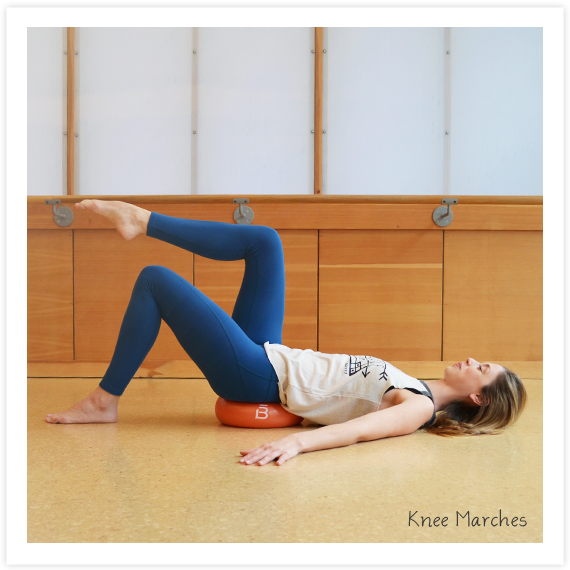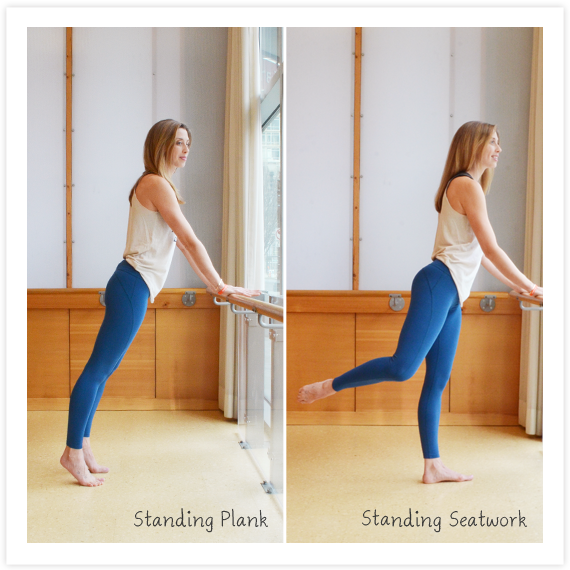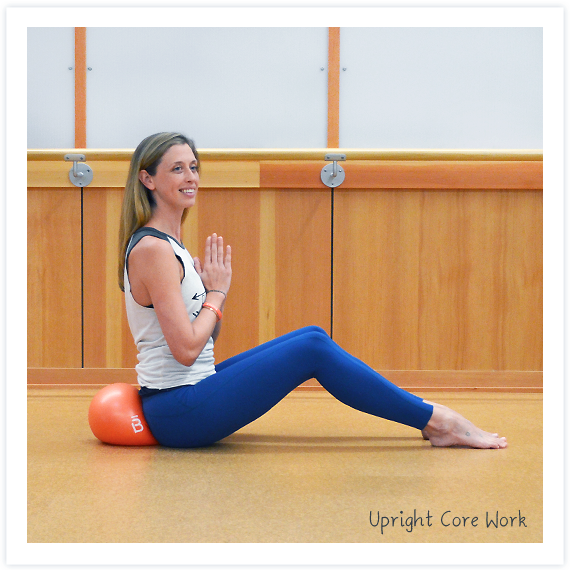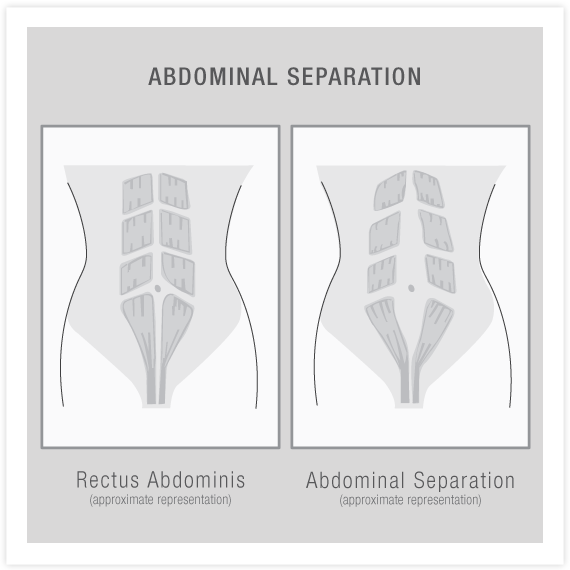Move
Modifications for Abdominal Separation
Abdominal separation is most closely associated with having a child. During pregnancy, your mid-section stretches and expands to make room for the baby. A normal reaction to a growing baby (and belly) is abdominal separation, which means the connective tissue between the rectus muscles (your six-pack muscles) stretches. Once the baby is born, the result of this separation is a core that is inherently weakened, a less stable pelvis, and an overall loss of functional strength. Weakened core muscles and pelvic instability are the perfect recipe for lower back pain and poor posture.
It’s important to know that abdominal separation isn’t isolated to women who’ve recently had a baby. People with body imbalances and anyone who does excessive amounts of heavy lifting can get diastasis recti. For moms it is caused by a growing baby, for others it is caused by genetics or excessive abdominal pressure from great strain. If you’re wondering whether or not you have diastasis recti, check with your doctor.
Here’s the good news: If you have abdominal separation, barre3 can help you regain the strength your body needs to be balanced and strong. According to the National Institute of Health, many with diastasis recti can heal their separation. By realigning the body and strengthening the muscles to stabilize your core, you can inhibit further separation and in many cases correct it so you’re able to move better functionally without pain.
How to modify during a barre3 workout:
Most women with post-natal abdominal separation think that they need to work their abdominals harder in order to heal. It’s counterintuitive, but this is not the time to be turbo. Instead, we recommend embracing subtle body work and modifying a few postures so that you build strength from the inside out. By doing so, you’ll get better results and find a sense of ease within your effort.

Modification 1: Avoid forward flexion of the spine.
What it is: Forward flexion of the spine occurs when the spine is bent forward in a rounded C curved position. In barre3, the spine is in a forward flexed position during core work on our backs when we’re lifting the upper body (like a crunch) or the lower body (like in knee catches) off the mat.
Why it’s not good: Forward flexion of the spine can put too much pressure on your abdominal wall and increase separation.
How to modify:
1. Avoid Mid-Core Work completely (when the ball is behind your shoulder blades) and work flat on your back instead.
2. Do not lift your head, neck, or shoulders off the ground during Incline Core work (when the ball is under your sacrum) or Flat-Back Core Work (when you’re lying flat on your back).
3. It’s equally important to avoid lifting both legs in the air during Incline and Flat-Back Core work. Knee Marches are the perfect modification for Mid-Core, Flat-Black, and Incline Core Work because they allow you to stabilize your pelvis and strengthen the deep layers of your core.

Modification 2: Take Plank Pose and All Fours at the ballet barre.
Why it’s not good: Plank pose and All Fours on the ground aggravate abdominal separation. When your stomach is parallel hovering over the floor, gravity increases the pressure on your linea alba and can cause further separation.
How to modify: We recommend standing at the ballet barre instead to take pressure off the abdominal wall. By doing this, you’re getting the same benefits with less pressure on the body.

Modification 3: Sit tall during Upright Core.
Why it’s not good: When you lean back during Upright Core Work (when the ball is wedged behind you), you put more weight on your core and risk increasing separation.
How to modify: Sit tall and avoid leaning backwards. By doing so, you’ll work the exact same muscles with less pressure.
While our studio owners and instructors are happy to offer modifications so that you get a safe and effective workout, we recommend talking to your doctor about abdominal separation. She or he will help you identify if you have it and what you can do to heal.
Do you have questions about abdominal separation? Ask us in the comments below!
Abdominal separation is most closely associated with having a child. During pregnancy, your mid-section stretches and expands to make room for the baby. A normal reaction to a growing baby (and belly) is abdominal separation, which means the connective tissue between the rectus muscles (your six-pack muscles) stretches. Once the baby is born, the result of this separation is a core that is inherently weakened, a less stable pelvis, and an overall loss of functional strength. Weakened core muscles and pelvic instability are the perfect recipe for lower back pain and poor posture.
It’s important to know that abdominal separation isn’t isolated to women who’ve recently had a baby. People with body imbalances and anyone who does excessive amounts of heavy lifting can get diastasis recti. For moms it is caused by a growing baby, for others it is caused by genetics or excessive abdominal pressure from great strain. If you’re wondering whether or not you have diastasis recti, check with your doctor.
Here’s the good news: If you have abdominal separation, barre3 can help you regain the strength your body needs to be balanced and strong. According to the National Institute of Health, many with diastasis recti can heal their separation. By realigning the body and strengthening the muscles to stabilize your core, you can inhibit further separation and in many cases correct it so you’re able to move better functionally without pain.
How to modify during a barre3 workout:
Most women with post-natal abdominal separation think that they need to work their abdominals harder in order to heal. It’s counterintuitive, but this is not the time to be turbo. Instead, we recommend embracing subtle body work and modifying a few postures so that you build strength from the inside out. By doing so, you’ll get better results and find a sense of ease within your effort.

Modification 1: Avoid forward flexion of the spine.
What it is: Forward flexion of the spine occurs when the spine is bent forward in a rounded C curved position. In barre3, the spine is in a forward flexed position during core work on our backs when we’re lifting the upper body (like a crunch) or the lower body (like in knee catches) off the mat.
Why it’s not good: Forward flexion of the spine can put too much pressure on your abdominal wall and increase separation.
How to modify:
1. Avoid Mid-Core Work completely (when the ball is behind your shoulder blades) and work flat on your back instead.
2. Do not lift your head, neck, or shoulders off the ground during Incline Core work (when the ball is under your sacrum) or Flat-Back Core Work (when you’re lying flat on your back).
3. It’s equally important to avoid lifting both legs in the air during Incline and Flat-Back Core work. Knee Marches are the perfect modification for Mid-Core, Flat-Black, and Incline Core Work because they allow you to stabilize your pelvis and strengthen the deep layers of your core.

Modification 2: Take Plank Pose and All Fours at the ballet barre.
Why it’s not good: Plank pose and All Fours on the ground aggravate abdominal separation. When your stomach is parallel hovering over the floor, gravity increases the pressure on your linea alba and can cause further separation.
How to modify: We recommend standing at the ballet barre instead to take pressure off the abdominal wall. By doing this, you’re getting the same benefits with less pressure on the body.

Modification 3: Sit tall during Upright Core.
Why it’s not good: When you lean back during Upright Core Work (when the ball is wedged behind you), you put more weight on your core and risk increasing separation.
How to modify: Sit tall and avoid leaning backwards. By doing so, you’ll work the exact same muscles with less pressure.
While our studio owners and instructors are happy to offer modifications so that you get a safe and effective workout, we recommend talking to your doctor about abdominal separation. She or he will help you identify if you have it and what you can do to heal.
Do you have questions about abdominal separation? Ask us in the comments below!













21 people have left a comment. Join the conversation!
View Comments